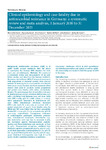2023-05-18Zeitschriftenartikel
Clinical epidemiology and case fatality due to antimicrobial resistance in Germany: a systematic review and meta-analysis, 1 January 2010 to 31 December 2021
Rödenbeck, Martin
Ayobami, Olaniyi
Eckmanns, Tim
Pletz, Matthias W.
Bleidorn, Jutta
Markwart, Robby
Background
Antimicrobial resistance (AMR) is of public health concern worldwide.
Aim
We aimed to summarise the German AMR situation for clinicians and microbiologists.
Methods
We conducted a systematic review and meta-analysis of 60 published studies and data from the German Antibiotic-Resistance-Surveillance (ARS). Primary outcomes were AMR proportions in bacterial isolates from infected patients in Germany (2016–2021) and the case fatality rates (2010–2021). Random and fixed (common) effect models were used to calculate pooled proportions and pooled case fatality odds ratios, respectively.
Results
The pooled proportion of meticillin resistance in Staphylococcus aureus infections (MRSA) was 7.9% with a declining trend between 2014 and 2020 (odds ratio (OR) = 0.89; 95% CI: 0.886–0.891; p < 0.0001), while vancomycin resistance in Enterococcus faecium (VRE) bloodstream infections increased (OR = 1.18; (95% CI: 1.16–1.21); p < 0.0001) with a pooled proportion of 34.9%. Case fatality rates for MRSA and VRE were higher than for their susceptible strains (OR = 2.29; 95% CI: 1.91–2.75 and 1.69; 95% CI: 1.22–2.33, respectively). Carbapenem resistance in Gram-negative pathogens (Klebsiella pneumoniae, Acinetobacter baumannii, Enterobacter spp. and Escherichia coli) was low to moderate (< 9%), but resistance against third-generation cephalosporins and fluoroquinolones was moderate to high (5–25%). Pseudomonas aeruginosa exhibited high resistance against carbapenems (17.0%; 95% CI: 11.9–22.8), third-generation cephalosporins (10.1%; 95% CI: 6.6–14.2) and fluoroquinolones (24.9%; 95% CI: 19.3–30.9). Statistical heterogeneity was high (I2 > 70%) across studies reporting resistance proportions.
Conclusion
Continuous efforts in AMR surveillance and infection prevention and control as well as antibiotic stewardship are needed to limit the spread of AMR in Germany.
Dateien zu dieser Publikation

